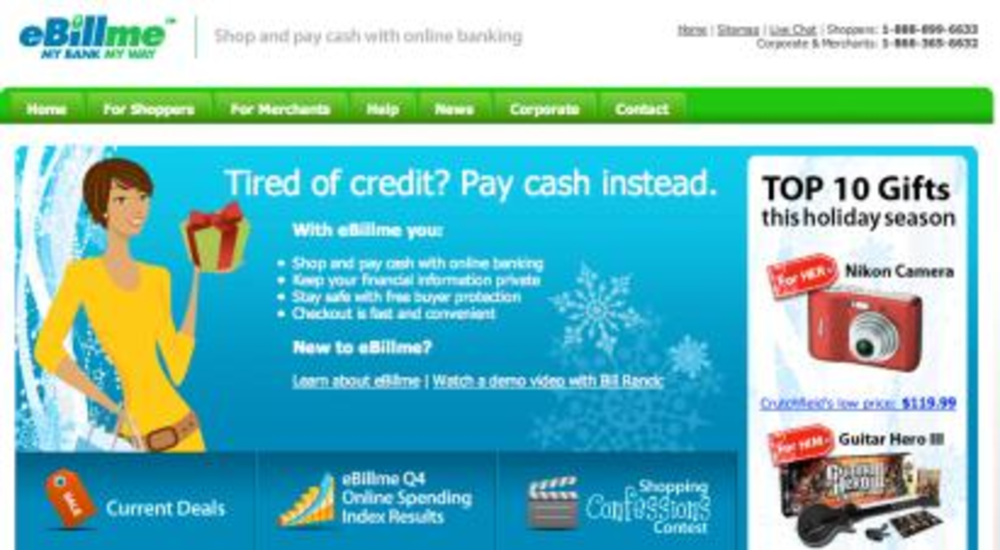There’s been a dramatic rise in the use of payment methods other than credit cards over the past few months.
Online home electronics retailer Etronics reports transaction volume through eBillme during the past two months has grown 35% on the site, according to Mark Zayats, marketing director at Etronics. While credit still accounts for the highest volume of transactions, eBillme is one of the top three payment methods offered by Etronics, he said.
EBillme offers consumers the ability to pay for online transactions using available cash from an online bank account without releasing any personal or financial information. “With the credit crunch that is happening right now, eBillme provides the consumer a great way not to get into credit card debt,” said Zayats.
Etronics is currently promoting a rebate offer from eBillme on its Web site and in pay-per-click advertising. In addition, in order to make this payment option available to even more consumers, Etronics recently became the first online retailer to offer a Spanish version of eBillme, and is promoting the new service to the Hispanic market.
Debit card use also is growing. “We’ve seen a continued movement toward debit vs. credit in the retail sector, reflecting the crunch on credit,” said Jason Pavona, VP of product management at payment processing company Litle & Co. The company, whose clients are predominantly in the direct marketing field, reports the volume of debit card transactions jumped significantly in the past 90 days and now represent upwards of 65% of transactions.
However, with most industry watchdogs expecting lower holiday spending this year, some credit card transactions may simply disappear.
“What we’re seeing is consumers using credit cards less,” said Bruce Cundiff, director of payments research and consulting at Javelin Strategy & Research. Because consumers are spending less, he added, some of those transactions may not necessarily shift to other methods.
Layaway, debit cards and the several online payment methods such as PayPal, Google Checkout, eBillme and Bill Me Later have been around for a while, but have traditionally accounted for only a small percentage of transactions during the holiday season.
This is beginning to change now that credit is harder to come by, and consumers are putting themselves on strict budgets. The trend toward alternative payment methods is most pronounced online, where there are many payment options.
This growth is expected to continue over the next few years. Alternative payment methods will represent an increasing percentage of overall retail dollar volume, increasing from 18% in 2008 to 31% by 2013, according to a recent study by Javelin Strategy & Research. Credit and debit cards account for the remaining volume. Some of the fastest growing methods during this period will be stored-value cards, such as prepaid debit cards, which Javelin predicts will grow at a rate of 41.8%; and on-the-spot credit, such as BillMeLater, expected to grow at a rate of 22.8%.
For consumers who don’t have credit cards, methods of payment like Bill Me Later, which was recently acquired by eBay/PayPal, or prepaid debit cards are sometimes their only option.
“As merchants offer other options for payment, they attract a broader range of consumers and drive incremental sales,” said Mia Shernoff, EVP of marketing, Chase Paymentech. As a result, a growing number of online merchants are offering alternative payment methods in an attempt to attract new customers.
Online retailers such as Sephora.com, iTunes.com and Footlocker.com have signed on for a holiday promotion with Facecard, a new prepaid Mastercard debit card that was introduced this summer. “The 12 days of facecard” promotion enters any active cardholder with a minimum balance into a daily drawing for electronic coupons that are automatically added to their Facecard.
“Prepaid debit cards seem to be a little bit less well known than debit cards and credit cards,” said Meaghan Schaefer, CMO at Edo Interactive. “However, we’re seeing tremendous growth in the prepaid category, which can be attributed to what is going on in the economy.”
Prepaid cards can be easily used as a budgeting tool when consumers load them with a specific amount that is their spending limit, said Schaefer.
Alternative payment methods offer another benefit to retailers: lower merchant fees than credit cards. This isn’t the deciding factor for merchants, however. “At the end of the day, merchants want to use methods that customers are choosing,” said Cundiff.
Alternative payment methods also are experiencing a surge in bricks-and-mortar stores this holiday season, in the form of layaway programs.
Based on the success that its sister chain Kmart has seen with its layaway program so far this year, Sears recently reintroduced a layaway program, enabling customers to pay in installments and pick up their purchases in time for the holidays.
“In this difficult economic climate, extending the layaway program at Sears is an easy decision and one that we hope will provide additional value to our customers,” said Don Hamblen, CMO at Sears, in a statement.








